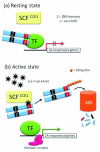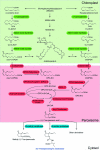Jasmonates
- PMID: 22303255
- PMCID: PMC3244945
- DOI: 10.1199/tab.0129
Jasmonates
Abstract
ARABIDOPSIS IS A SUPERB MODEL FOR THE STUDY OF AN IMPORTANT SUBGROUP OF OXYLIPINS: the jasmonates. Jasmonates control many responses to cell damage and invasion and are essential for reproduction. Jasmonic acid (JA) is a prohormone and is conjugated to hydrophobic amino acids to produce regulatory ligands. The major receptor for active jasmonate ligands is closely related to auxin receptors and, as in auxin signaling, jasmonate signaling requires the destruction of repressor proteins. This chapter uses a frequently asked question (FAQ) approach and concludes with a practical section.
Figures




References
-
- Bannenberg G., Martínez M., Ham berg M., Castresana C. Diversity of the enzymatic activity in the lipoxygenase gene family of Arabidopsis thaliana. Lipids. 2009a;448(1):85–95. - PubMed
-
- Bari R., Jones J.D. Role of plant hormones in plant defence responses. Plant Mol. Biol. 2009;698(1):473–488. - PubMed
LinkOut - more resources
Full Text Sources
Research Materials
